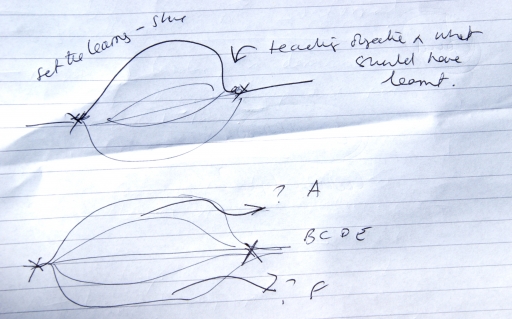'Media Component' is the term, like e-learning, that I believe will supersede most others to define the activities, or 'e-tivities' (not sticking) Salmon (2002) that learning designers put into or developers and builders devise for e-learning modules or courses.
Media components are, if you like, the stepping stones that take a learner from ignorant to informed, with learning objectives the aim, but increasingly with effectiveness through greater engagement as we move away from the chronology of the stepping stone, itself a derivation of turning to the next page towards something more exploratory, game–like, intuative and where appropriate – in context for the learning. Where better to learn about health and safety for the nuclear power industry than in a nuclear power plant, where better learn to apply best practice in a retail bank than in the banking hall.
Twelve years ago these media components were described as Lego building blocks (Downes, 2000), though in practice they are more akin to Lego Technics (Pegler, 2002) - they do something. Coming from a background in linear and non-linear (interactive) video-based corporate training, I am trying to think what terms and expressions we used on the paper storyboard pads on which the interactions were devised?
Perhaps as they were added to linear video sequences and derived from scripts written in this form they were 'interactions' or 'interactivities'.
They were built into the narrative like an action sequence we shot as video.
For a while, as we migrated such content to the Web we called it all 'stuff' as a catch-all for content, whether it did something or not.
(A decade on I am yet to see anything as engaging or rich as the DVDs we produced in the 1990s with broadcast standard drama reconstruction or 3d animations, winners of IVCA Gold for their originality, impact and efffectiveness).
Today we are still producing the web-page derived equivalent of the leaflet or workbook, not least because it has taken broadband speeds and the devices and infrastructure a decade to catch–up.
The greatest shift has been to put the learning in our hands on Smartphones and Tablets and with this the desire for greater game–like tactility.
I wonder if another metaphor might be a sequence in music, a number of bars, a phrase that has a certain effect. This might be another way to design the actions.
An architect works on 2D blueprints to create buildings in three dimensions; composers use a score to lay–out music that surrounds us and touches us, film–makers have scripts and storyboards.
If we use PowerPoint to express a sequence or selection of interactivities, of 'media components' or 'learning activities' no wonder they are linear rather than exploratory.
We need to design onto maps and navigate as our heads do – independently.
| From Lady Anne Clifford's Great Picture 1646 |
I am drawn to the image of a 17th century triptych, the Great Picture that expresses the life story of Lady Anne Clifford. There is logic to the left and right panels, Lady Anne age 15 and 76 respectively, while the borders, like going around a game–board give ancestors, relatives, and artefacts any of which, in the 21st century could be brought to life with a link at least or an interaction at best, even in Web 2.0 terms the opportunity to share with others synchronously or asynchronously.
I've heard the phrase 'sand-pit' used too, the thought that you do these things in a playful, perhaps even in an incomplete way, measuring effectiveness will be the driver - media components that work or sequences that have a ressonance for a topic or audience will be used again.
This should not however be at the cost of accessibility. Anyone can play in a sandpit, but not everyone can play in an orchestra or all the instruments in it.
Various metaphors have been applied and can be applied, like building with Lego blocks Downes (2000) though Pegler’s preferences is to make a comparison with Technic ‘Lego’ (Pegler, 2004:Loc4282) where each piece has a set of actions. Wiley imwgined them to be more like atoms (2001). The reality is more mundane, your e-learning module can be like a marathon or the 400m hurdles, with some imagination it can be a triathlon or heptathlon even the modern pentathlon.
The conclusion is that when construction e-learning we need to look for and create digital resources that are:
1. Easily sourced
2. Durable
3. Easily Maintained
4. Accessible
5. Free from legal limitations
6. Quality assured
7. Appropriate cost
8. Resizable
9. Easily repurposed
10. Meaningful
11. Engages the learner
12. Intelligible
To this list of qualities I would add a thirteenth: desirable - is it a media component or activity (e-tivity, Salmon 2002) that your colleagues want to use when building the module, let alone something users take to when faced eith it. And then can it be used too often or inappropriately?
And a fourteenth - they should be reusable too, readily combined, reskinned and rebranded like type in a printing press that can be reused, or a component in a game from picking a card, rolling the dice or answering a question correctly. Is this media component transportable?
In an e-learning module these are multichoice, complete a phrase, connect or put into order.
And a fifteenth – and surely at the top of the list: effective.
Which probably means a sixteenth – measurable, or accountable. We want to know how it behaves and derive meaningful anslytics from it.
Even a seventeenth – fashionsble, or at least of the age, suited to the user group, appropriate for the identified personas doing the learning.
Downes, S (2000) Learning Objects. Available from http://www.newstrolls.com/news/dev/downes/col;umn000523_1.htm
Littlejohn, Falconer, Mcgill (2008) Characterising effective eLearning (sic) resources
Pegler, C and Littlejohn, A (2004) Preparing for Blended e-Learning, Routledge.
Salmon, G (2002) E-tivities
Wiley, D.A. (2000) Connecting Learning Objects to instructional design theory: a definition, a metaphor, and a taxonomy. In D.A. Wiley (ed), The instructional use of Learning Objects. Available from http://reusability.org/read/chapters/wiley.doc



